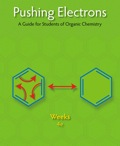
EBK PUSHING ELECTRONS
4th Edition
ISBN: 9781285633237
Author: Weeks
Publisher: CENGAGE LEARNING - CONSIGNMENT
expand_more
expand_more
format_list_bulleted
Question
Chapter 2, Problem 20EQ
Interpretation Introduction
Interpretation:
The resonance structure of the given molecule is to be determined
Concept Introduction:
When the electron distribution of a molecule can be depicted correctly in more than one way using different Lewis structures, the drawings are called resonance structures.
Resonance structures have no discrete existence of their own but, taken in combination, describe the true structure of the molecule.
Expert Solution & Answer
Trending nowThis is a popular solution!

Students have asked these similar questions
Identify the starting material in the following reaction. Click the "draw structure" button to launch the
drawing utility.
draw structure ...
[1] 0 3
C10H18
[2] CH3SCH3
H
What alkene or alkyne yields the following products after oxidative cleavage with ozone? Click the
"draw structure" button to launch the drawing utility.
and two equivalents of CH2=O
draw structure ...
H-Br
Energy
1) Draw the step-by-step mechanism by which 3-methylbut-1-ene is converted into
2-bromo-2-methylbutane.
2) Sketch a reaction coordinate diagram that shows how the internal energy (Y-
axis) of the reacting species change from reactants to intermediate(s) to product.
Br
Chapter 2 Solutions
EBK PUSHING ELECTRONS
Ch. 2 - One Lewis structure for the 2-butenyl cation is...Ch. 2 - Prob. 2EQCh. 2 - One structure for the conjugate acid of acetone...Ch. 2 - Similarly, a resonance structure for the conjugate...Ch. 2 - Prob. 5EQCh. 2 - Pairs of unshared electrons can be pushed. One...Ch. 2 - One structure for the acetoxonium ion is Clearly,...Ch. 2 - Prob. 8EQCh. 2 - There are no important resonance structures for...Ch. 2 - Prob. 10EQ
Ch. 2 - Prob. 11EQCh. 2 - Prob. 12EQCh. 2 - Prob. 13EQCh. 2 - Prob. 14EQCh. 2 - Prob. 15EQCh. 2 - Prob. 16EQCh. 2 - Prob. 17EQCh. 2 - The cyclohexane carboxylate anion has a Lewis...Ch. 2 - One Lewis structure for the enolate anion of...Ch. 2 - Prob. 20EQCh. 2 - Prob. 21EQCh. 2 - Prob. 22EQCh. 2 - Prob. 23EQCh. 2 - Prob. 24EQCh. 2 - Prob. 25EQCh. 2 - Prob. 26EQCh. 2 - Prob. 27EQCh. 2 - Prob. 28EQ
Knowledge Booster
Similar questions
- 2. Draw the missing structure(s) in each of the following reactions. The missing structure(s) can be a starting material or the major reaction product(s). C5H10 H-CI CH2Cl2 CIarrow_forwardDraw the products of the stronger acid protonating the other reactant. དའི་སྐད”“ H3C OH H3C CH CH3 KEq Product acid Product basearrow_forwardDraw the products of the stronger acid protonating the other reactant. H3C NH2 NH2 KEq H3C-CH₂ 1. Product acid Product basearrow_forward
- What alkene or alkyne yields the following products after oxidative cleavage with ozone? Click the "draw structure" button to launch the drawing utility. draw structure ... andarrow_forwardDraw the products of the stronger acid protonating the other reactant. H3C-C=C-4 NH2 KEq CH H3C `CH3 Product acid Product basearrow_forward2. Draw the missing structure(s) in each of the following reactions. The missing structure(s) can be a starting material or the major reaction product(s). C5H10 Br H-Br CH2Cl2 + enant.arrow_forward
- Draw the products of the stronger acid protonating the other reactant. KEq H₂C-O-H H3C OH Product acid Product basearrow_forwardDraw the products of the stronger acid protonating the other reactant. OH KEq CH H3C H3C `CH3 Product acid Product basearrow_forward2. Draw the missing structure(s) in each of the following reactions. The missing structure(s) can be a starting material or the major reaction product(s). Ph H-I CH2Cl2arrow_forward
- 3 attempts left Check my work Draw the products formed in the following oxidative cleavage. [1] 03 [2] H₂O draw structure ... lower mass product draw structure ... higher mass productarrow_forward2. Draw the missing structure(s) in each of the following reactions. The missing structure(s) can be a starting material or the major reaction product(s). H-Br CH2Cl2arrow_forwardWrite the aldol condensation mechanism and product for benzaldehyde + cyclohexanone in a base. Then trans-cinnamaldehyde + acetone in base. Then, trans-cinnamaldehyde + cyclohexanone in a base.arrow_forward
arrow_back_ios
SEE MORE QUESTIONS
arrow_forward_ios
Recommended textbooks for you

 Chemistry by OpenStax (2015-05-04)ChemistryISBN:9781938168390Author:Klaus Theopold, Richard H Langley, Paul Flowers, William R. Robinson, Mark BlaserPublisher:OpenStax
Chemistry by OpenStax (2015-05-04)ChemistryISBN:9781938168390Author:Klaus Theopold, Richard H Langley, Paul Flowers, William R. Robinson, Mark BlaserPublisher:OpenStax Chemistry: The Molecular ScienceChemistryISBN:9781285199047Author:John W. Moore, Conrad L. StanitskiPublisher:Cengage Learning
Chemistry: The Molecular ScienceChemistryISBN:9781285199047Author:John W. Moore, Conrad L. StanitskiPublisher:Cengage Learning Organic ChemistryChemistryISBN:9781305580350Author:William H. Brown, Brent L. Iverson, Eric Anslyn, Christopher S. FootePublisher:Cengage Learning
Organic ChemistryChemistryISBN:9781305580350Author:William H. Brown, Brent L. Iverson, Eric Anslyn, Christopher S. FootePublisher:Cengage Learning Chemistry for Today: General, Organic, and Bioche...ChemistryISBN:9781305960060Author:Spencer L. Seager, Michael R. Slabaugh, Maren S. HansenPublisher:Cengage Learning
Chemistry for Today: General, Organic, and Bioche...ChemistryISBN:9781305960060Author:Spencer L. Seager, Michael R. Slabaugh, Maren S. HansenPublisher:Cengage Learning


Chemistry by OpenStax (2015-05-04)
Chemistry
ISBN:9781938168390
Author:Klaus Theopold, Richard H Langley, Paul Flowers, William R. Robinson, Mark Blaser
Publisher:OpenStax

Chemistry: The Molecular Science
Chemistry
ISBN:9781285199047
Author:John W. Moore, Conrad L. Stanitski
Publisher:Cengage Learning

Organic Chemistry
Chemistry
ISBN:9781305580350
Author:William H. Brown, Brent L. Iverson, Eric Anslyn, Christopher S. Foote
Publisher:Cengage Learning


Chemistry for Today: General, Organic, and Bioche...
Chemistry
ISBN:9781305960060
Author:Spencer L. Seager, Michael R. Slabaugh, Maren S. Hansen
Publisher:Cengage Learning